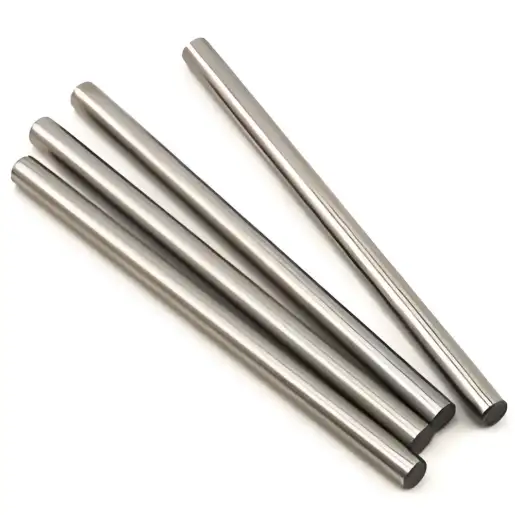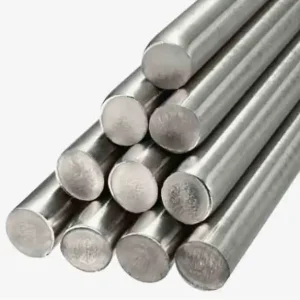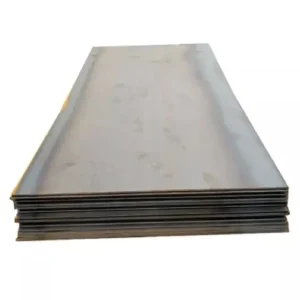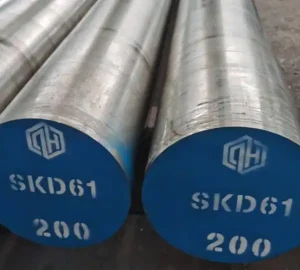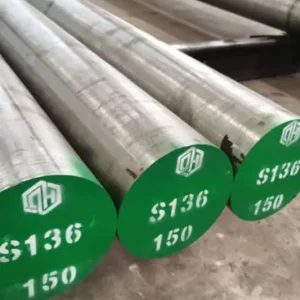Incoloy® 825 (UNS N08825 / W.Nr. 2.4858) round bar is a high-performance austenitic nickel-iron-chromium alloy engineered for exceptional resistance to both oxidizing and reducing environments (notably sulfuric and phosphoric acids), strong resistance to chloride-induced stress corrosion cracking, and good mechanical performance from cryogenic temperatures up to roughly 538°C (1000°F). For demanding chemical-processing, pollution-control, oil & gas and marine applications where corrosion resistance and fabricability are essential, Incoloy 825 round bar provides a cost-effective, weldable, and readily available form factor.
What is alloy 825 material?
Incoloy® 825 is a nickel-iron-chromium austenitic alloy developed for aqueous corrosion resistance where both oxidizing and reducing media are present. It contains deliberate additions of molybdenum, copper and titanium that increase resistance to localized attack (pitting/crevice), improve performance against sulfuric and phosphoric acids, and reduce the susceptibility to chloride stress-corrosion cracking. In industrial practice it is supplied as plate, sheet, strip, pipe, tube, wire and — relevant here — round bar and rod for machining and fabrication.
Chemical composition (typical specification)
Below is a practical chemical composition table commonly used for wrought Incoloy 825 (UNS N08825). These ranges match standard datasheets and mill specifications; purchase orders for critical service should quote the exact standard and required test certificates (e.g., mill test report / chemical analysis).
Chemical composition (wt%) — typical ranges
| Element | Typical range (wt%) |
|---|---|
| Nickel (Ni) | 38.0 – 46.0 |
| Chromium (Cr) | 19.5 – 23.5 |
| Iron (Fe) | Balance (~22% min) |
| Molybdenum (Mo) | 2.50 – 3.50 |
| Copper (Cu) | 1.50 – 3.00 |
| Titanium (Ti) | 0.06 – 1.20 |
| Manganese (Mn) | ≤ 1.00 |
| Silicon (Si) | ≤ 0.50 |
| Carbon (C) | ≤ 0.05 |
| Sulfur (S) | ≤ 0.03 |
| Aluminum (Al) | ≤ 0.20 |
| Phosphorus (P) | ≤ 0.03 |
(Source data summary from manufacturer technical bulletins and datasheets.)
Comment: Copper and molybdenum are the principal alloying additions that give Alloy 825 its very good resistance in reducing acids; titanium stabilizes the alloy against intergranular attack following welding or high-temperature service.
Material properties — mechanical & physical summary
A concise engineering table for commonly used (annealed / mill) properties of Incoloy 825. Actual certified test numbers must come from the mill certificate for each heat lot.
Material properties (typical, annealed condition)
| Property | Typical value |
|---|---|
| Density | 8.14 g/cm³ (8140 kg/m³) |
| Tensile strength (Rm) | ~590–690 MPa (varies by form/finishing) — typical datasheet ranges |
| Yield strength (0.2% offset) | ~241–324 MPa (depends on temp & condition) |
| Elongation (in 50 mm or 2") | ≥ 30–45% (annealed) |
| Hardness (typical) | Rockwell B ~135–165 (HRB) ≈ Vickers ~130–150 HV (conversion varies by source) |
| Operating temperature | Useful mechanical properties up to ~538°C (1000°F); elevated temperature limitations apply depending on environment. |
| Magnetic behavior | Essentially non-magnetic in annealed austenitic condition (μ close to 1.005). |
Notes on hardness: typical mill-annealed hardness values are in the HRB band above. The alloy is strengthened primarily by cold work rather than by heat treatment.
Citations for the physical and mechanical property table come from supplier datasheets and manufacturer literature used by distributors and mills.
What is an Alloy 825 round bar made of
Alloy 825 is an austenitic, solid-solution strengthened nickel-iron-chromium alloy. In the as-supplied (hot-finished, annealed or cold-drawn) state the microstructure is austenitic (face-centered cubic). There is no precipitation-hardening (no age-hardening stage like some nickel alloys); mechanical strengthening is achieved by cold work (rolling/drawing) or by selecting a specific temper. Titanium in the chemistry acts as a stabilizer to tie up carbon and inhibit carbide precipitation at grain boundaries during thermal exposure, improving resistance to intergranular corrosion after welding.
Incoloy 825 vs. 316L stainless steel
Many buyers consider 316L because it's cheaper. Below is a practical comparison to help material selection.
Short answer: 316L (austenitic stainless steel) is an economical performer with good general corrosion and seawater resistance; Incoloy 825 delivers significantly better resistance in strongly reducing acid environments (sulfuric, phosphoric), better resistance to chloride stress-corrosion cracking, and greater immunity to localized attack in many aggressive chemical environments — but at higher raw-material cost.
Comparison table
| Characteristic | Incoloy 825 (UNS N08825) | 316L (UNS S31603) |
|---|---|---|
| Principal alloying | Ni 38–46, Cr 19.5–23.5, Mo 2.5–3.5, Cu 1.5–3.0, Ti 0.06–1.2 | Fe balance, Cr ~16–18, Ni ~10–14, Mo ~2–3 |
| Corrosion resistance | Superior in reducing acids (sulfuric, phosphoric), better SCC resistance in chloride environments | Good general corrosion and seawater resistance; less resistant to reducing acids and SCC in aggressive sour conditions |
| Mechanical performance | Higher nickel content gives better SCC resistance & ductility at low temp | Adequate for many general applications |
| Weldability | Good; titanium minimizes sensitization if correctly processed | Good; 316L low carbon reduces sensitization risk |
| Typical use case | Chemical plants, acid process equipment, sour oil & gas, pickling tanks, nuclear fuel processing | Food, pharma, marine construction, general piping |
| Cost | Higher (nickel content drives price) | Lower (widely available commodity stainless) |
(Selection note: when sulfuric or phosphoric acid, chlorides with risk of SCC, or high-integrity process equipment is in view, Alloy 825 is typically the safer choice.)
Alloy 825 bar specifications and equivalents
Common designations and equivalents
-
Trade name / common name: Incoloy® 825 (trademark of Special Metals).
-
UNS: N08825.
-
W.Nr (EN Werkstoff No.): 2.4858.
-
BS: NA16 (common UK/British designation).
-
Typical ASTM / ASME standards used for forms:
-
Rods, bars, forgings: ASTM B425 / ASTM B564 / ASME SB425 / ASME SB564 (see supplier datasheets).
-
Plate & sheet: ASTM B424 / ASME SB424.
-
Tubing / heat-exchanger: ASTM B423 / ASME SB163 (applications vary).
-
-
NACE / sour service: Alloy 825 is included in tables and guidance for alloys usable in H₂S-containing (sour) environments per NACE MR0175 / ISO 15156 (selection requires checking the specific environment/temperature/partial pressure limits).
Equivalent trade names you may encounter: Nickelvac 825, Alloy 825, and other mill brands or seller trade marks — always confirm UNS and composition on the certificate.
Size & weight — practical round bar quick-reference
Use the material density (8.14 g/cm³) to compute the linear weight. Below is a practical table for common round bar diameters — weights are kg per meter (useful for quoting, handling and postage).
Weight per metre — Incoloy 825 round bar (density = 8.14 g/cm³ = 8140 kg/m³)
| Diameter (mm) | Weight (kg/m) |
|---|---|
| 6 | 0.2302 |
| 8 | 0.4092 |
| 10 | 0.6393 |
| 12 | 0.9206 |
| 16 | 1.6366 |
| 20 | 2.5573 |
| 25 | 3.9957 |
| 30 | 5.7538 |
| 40 | 10.2290 |
| 50 | 15.9829 |
| 60 | 23.0153 |
| 80 | 40.9161 |
| 100 | 63.9314 |
| 200 | 255.7256 |
(Formula used: weight per metre = density (kg/m³) × area (m²) = 8140 × π × (d/1000)² / 4). These values are rounded to four decimals; always use measured diameters for final procurement or machining calculations.)
Global pricing snapshot 2025
Metal prices move with nickel and molybdenum markets, processing form (bar/rod vs plate vs pipe), quantity, finish, and local taxes/logistics. Below are market range examples for 2025 based on recent supplier listings and China export price posts — treat these as indicative, not firm quotes. For project budgeting always request a formal quote with lead time and certificates.
Indicative price ranges (USD per kg) — 2025 (approx.)
| Region / source | Typical range (USD/kg) |
|---|---|
| China (manufacturers / trading listings) | US$ 18 – 52 / kg (depending on form, MOQ, finish) |
| China recent plate/bar market posts (April 2025) | US$ 32 – 48 / kg (plate/flat higher; small quantity premiums) |
| India / European distributors | US$ 28 – 65 / kg (smaller orders, distributor margin, certification costs) |
| USA / distributor stock | US$ 40 – 90 / kg (stock, quick delivery, certified MTRs) |
Important caveats:
-
These ranges reflect small-to-medium quantity listings and distributor stock advertising. Bulk mill orders and long-term frame contracts can produce substantially different unit prices.
-
Raw nickel and molybdenum price swings, currency, freight, import duties, and testing/certification requirements significantly affect the delivered price.
-
For precise budget or tender figures, request an itemized formal quote (EXW / FOB / CIF / DAP) from the supplier including MTC, heat treatment (if any), and finish specification.
Typical dimensions, tolerances & finish for round bar
Common supply forms and considerations for round bar:
-
Standard lengths: hot-finished/forged bars often supplied in 2,000–6,000 mm lengths; cut-to-size available on request.
-
Diameters: small bright bars may start at a few mm; forged/rolled rounds commonly stocked from 6 mm up to several hundred mm (depending on mill capability).
-
Surface finish: hot-rolled, cold-finished (bright), centerless ground — specify for machining accuracy.
-
Certifications: typically Mill Test Report (EN 10204 / 3.1 or 3.2) is requested for critical service.
-
Tolerances: follow ASTM/ASME or customer drawing tolerances — distributors publish size/tolerance charts for their stocked rounds.
Fabrication, machining & welding notes
-
Machining: Incoloy 825 machines more easily than many high-nickel superalloys but harder than common stainless steels; use sharp carbide tooling and positive rake geometry; control heat at the tool/work interface to avoid work-hardening.
-
Welding: Readily weldable by standard methods (GTAW, GMAW, SMAW) with compatible filler metals. Titanium and controlled heat input help avoid sensitization. No post-weld heat treatment is generally required for corrosion resistance if proper procedures are followed, but always reference the weld procedure specification (WPS).
-
Forming: Good formability in annealed condition; cold work increases strength but reduces ductility.
-
Heat treatment: Annealing typically around 955°C (1750°F) followed by controlled cooling (per datasheet). Cold working is the standard method for strengthening.
Applications for round bar
Incoloy 825 round bar is typically machined into: valve components, pump shafts, fasteners/bolts for acid environments, thermowells, sensors and probe bodies, down-hole tooling components, fittings and shafts for pollution control equipment, components for chemical plants (acid pickling, phosphoric/sulfuric acid equipment), and nuclear fuel reprocessing hardware. Its use is chosen where corrosion performance, fabricability and weldability are jointly required.
MWAlloys offering — what we provide
MWAlloys is a China-based manufacturer and stockholder of nickel-base and high performance alloys. For Incoloy 825 round bar we offer:
-
Stocked diameters and cut-to-size lengths — standard inventory for quick dispatch.
-
100% factory price (direct mill or factory supply pricing) — competitive, transparent pricing for OEM and project buyers.
-
Fast delivery on stocked items — express handling for sample and small production runs.
-
Full documentation available (MTR / chemical analysis / mechanical test certificates) on request.
-
Customization (forged billets, turned & ground bar, certified heat treat) available for volume orders.
If you want MWAlloys to prepare a formal quote, include quantity, required standard (e.g., ASTM B425 / ASME SB425), diameter, length and certificate level (e.g., EN 10204 3.1 or 3.2). We specialize in industrial quantities for global procurement and support packaging + export documentation for safe transit.
FAQs
-
Is Incoloy 825 magnetic?
No — it is essentially non-magnetic in the annealed austenitic condition. -
Can I weld Incoloy 825 bar without post-weld heat treatment?
Yes in most cases; the alloy is stabilized and usually requires no PWHT for corrosion resistance — follow qualified WPS and check project specs. -
What certificates will come with the bar?
Typical supply includes Mill Test Report (EN 10204 3.1 or 3.2 on request); for regulated industries additional documentation may be required. -
Is Incoloy 825 suitable for sour oil & gas (H₂S) service?
It is listed among alloys addressed in NACE MR0175/ISO 15156 guidance; selection depends on partial pressure, temperature and chloride content — verify against NACE/ISO tables. -
How is hardness affected by cold work?
Hardness increases with cold work — alloy 825 is typically softened by annealing and strengthened by cold drawing/rolling. -
What is the density used to calculate weight?
Use 8.14 g/cm³ (8140 kg/m³) for weight/volume calculations. -
Are there lower-cost alternatives?
For many non-critical uses 316L or duplex stainless steels are cheaper; but they lack the same resistance in reducing acids and to SCC in some chloride/sour conditions. -
Can Incoloy 825 be machined with standard stainless steel tooling?
Yes, but tooling selection and cutting parameters should be adjusted higher than for 316L to avoid work-hardening — carbide inserts and controlled feeds are recommended. -
What tolerances and finishes are common?
Hot-finished, cold-finished, or ground rounds are standard; tolerances vary with the finish — request supplier tolerances or follow ASTM/ISO where applicable. -
How quickly can MWAlloys deliver?
For stocked sizes, MWAlloys can dispatch quickly (inventory lead times depend on quantity); for special sizes or certified mill lots, lead time reflects production and testing — please request a formal lead-time in the RFQ.

